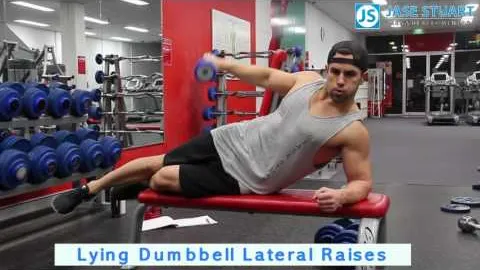
Lying Dumbbell Lateral Raise Exercise: A Comprehensive Guide
Improve Your Shoulder Strength and Stability
The lying dumbbell lateral raise exercise is a fantastic way to target the lateral deltoid muscles, which are located on the side of your shoulders. By incorporating this exercise into your regular workout routine, you can improve your shoulder strength and stability, enhance the appearance of your shoulders, and enhance your overall upper body aesthetic.
In this comprehensive guide, we will walk you through the proper form, benefits, variations, and tips to optimize your lying dumbbell lateral raise exercise. So, let's dive in and learn more about this effective shoulder exercise.
Before you start performing the lying dumbbell lateral raise exercise, it is crucial to maintain proper form for optimal results and to prevent injuries. Here's a step-by-step guide on how to execute the exercise correctly:
Remember to start with lighter weights and gradually increase the weight as your strength and comfort level improve.
Incorporating the lying dumbbell lateral raise exercise into your fitness regimen offers several significant benefits. Let's explore them:
Targeted Shoulder Activation: The primary focus of this exercise is the lateral deltoids, which helps improve shoulder width and give your upper body a balanced appearance.
Improved Shoulder Strength: By repeatedly engaging and challenging your shoulder muscles with this exercise, you can significantly increase their overall strength and stability.
Muscle Isolation: The lying position on the incline bench minimizes the involvement of other muscle groups, ensuring that your lateral deltoids are effectively targeted.
Enhanced Upper Body Aesthetics: Strengthening your lateral deltoids can enhance the overall aesthetics of your upper body, contributing to a more defined and sculpted appearance.
Injury Prevention: Strengthening the shoulders helps prevent common shoulder injuries and pain caused by weak or imbalanced muscles.
Once you have become comfortable with the basic lying dumbbell lateral raise exercise, you have the option to add variety and progressions to continue challenging your muscles. Here are a few variations to consider:
Seated Lying Dumbbell Lateral Raise: Perform the exercise while seated on an incline bench, maintaining the same form and movement pattern.
Unilateral Lying Dumbbell Lateral Raise: Instead of using both dumbbells simultaneously, focus on one arm at a time for increased muscle activation and control.
Resistance Band Lying Dumbbell Lateral Raise: Incorporate a resistance band around your wrists to add external resistance and increased difficulty.
Drop Sets: Perform a set of lying dumbbell lateral raises with a heavier weight, followed by a set with a lighter weight to further fatigue the muscles.
It is essential to carefully incorporate variations and progressions into your workout routine to avoid overexertion and potential injury. Consult with a fitness professional to determine the suitability of specific variations based on your fitness level and goals.
To get the most out of your lying dumbbell lateral raise exercise, keep these helpful tips in mind:
Maintain Control: Focus on controlled and deliberate movements throughout the exercise. Avoid swinging your arms or using momentum to lift the weights.
Engage Your Core: Activate your core muscles by drawing your navel in towards your spine. This will help stabilize your body and prevent any excessive arching or swaying.
Breathe Properly: Exhale as you lift the dumbbells and inhale as you lower them. Consistent breathing patterns ensure oxygen flows to your muscles, aiding their performance and preventing dizziness.
Warm-Up Properly: Prioritize a thorough warm-up before performing the lying dumbbell lateral raise exercise. Incorporate dynamic stretches and movements to increase blood flow to your shoulder and surrounding muscles.
Gradual Progression: Increase the weight or intensity gradually over time to challenge your muscles progressively. Sudden jumps in weight can lead to strain or injury.
By following these tips, you can optimize your lying dumbbell lateral raise exercise experience and maximize your results.
The lying dumbbell lateral raise exercise is an effective way to target and strengthen your lateral deltoids, improving shoulder strength, stability, and overall upper body aesthetic. By incorporating this exercise into your routine, you can enjoy the benefits of enhanced shoulder activation, muscle isolation, and injury prevention.
Remember to maintain proper form, experiment with variations when appropriate, and follow the recommended tips to optimize your results. With consistency and dedication, the lying dumbbell lateral raise exercise can help you achieve your fitness goals and attain strong, sculpted shoulders. Start incorporating this exercise into your routine today and take your upper body workout to the next level!
If you're looking for a gym, fitness club or yoga studio, you've come to the right place.
You can find information about gyms in your area. Browse catalog of gyms and find gyms with classes which are you looking for.
On gym page you can find simple information like address, phone or website. You can find list of available classes. You can check availability of personal training or small group classes. On place page you can also see information about open hours.
You can find gyms near you with amenities, courts, studios and equipments.
Use our map to find gym at your city or district.
In Gym Navigator you can find list of exercises with movies for many body parts.
You can browse exercises catalog and find exercises the best of you.
You can also find exercises grouped into workout plans, which you can use to improve you body. Each routine show you exercises one by one and give you possibility to count you progress and count down rest time.